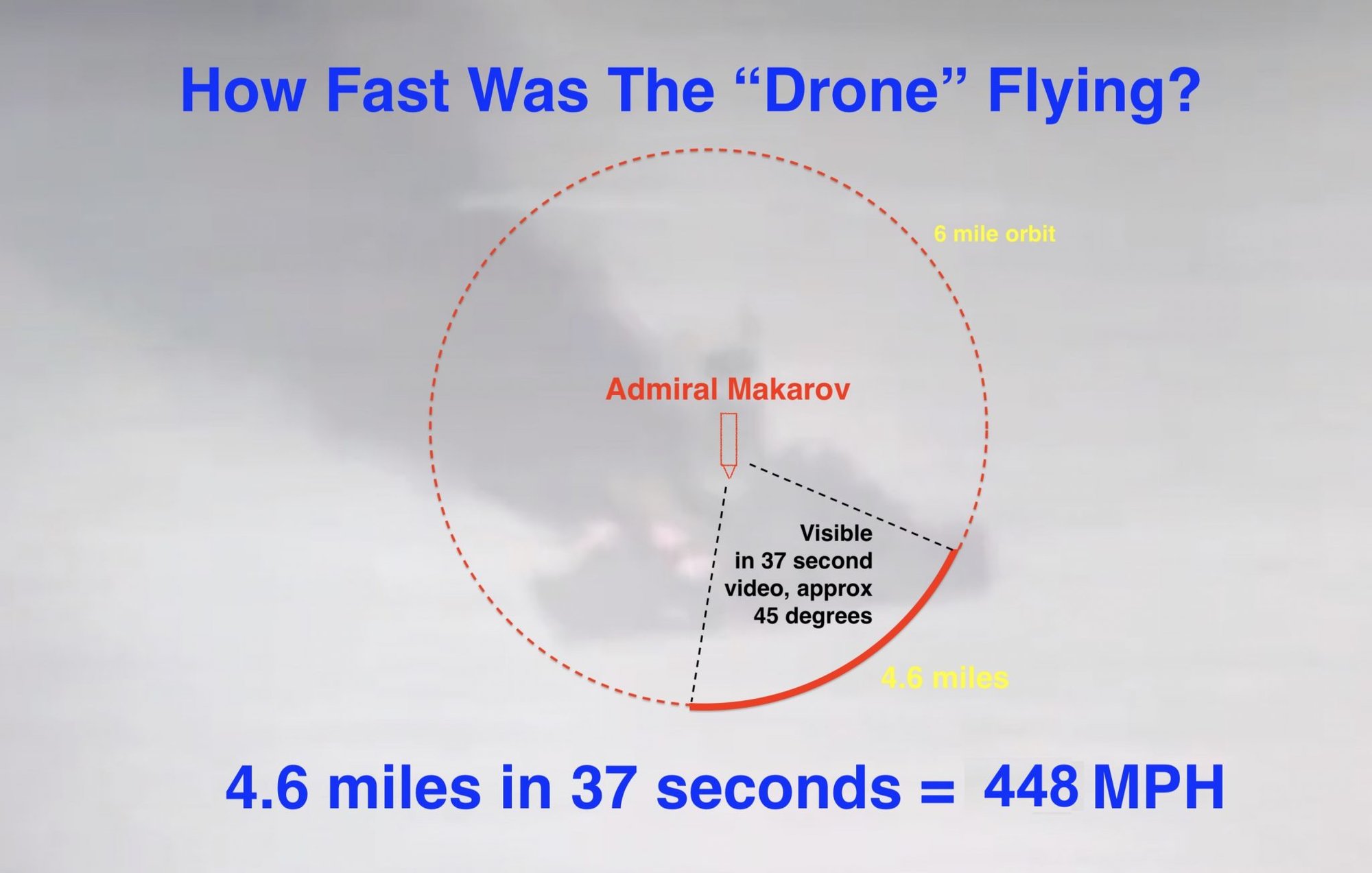‘Burning Russian Warship’ Admiral Makarov Video Is Almost Certainly Fake
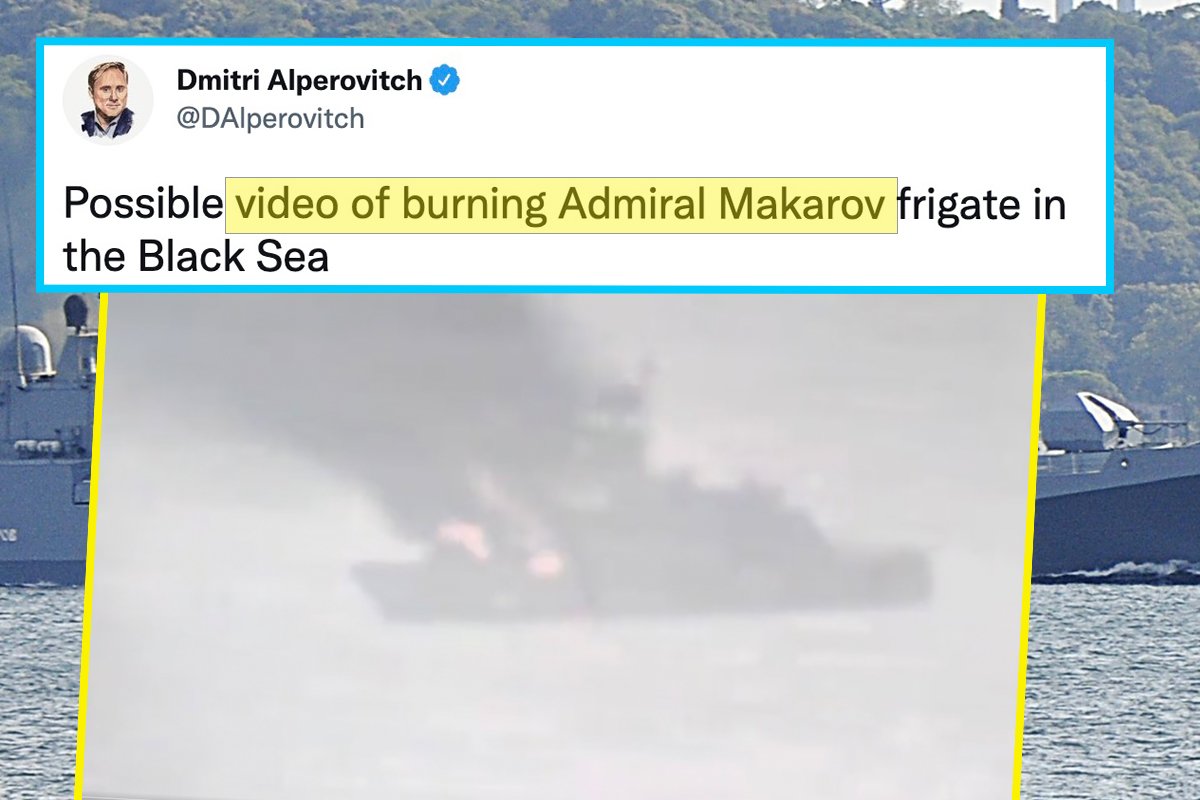
A video of a “burning” Russian warship circulated widely Friday, said to be the 400-foot frigate Admiral Makarov. But several problems with the video mark it as a very likely fake. Photo by Muhammed Gencebay Gur/Anadolu Agency via Getty. Composite by Coffee or Die.
Did the Ukrainians get another one? Probably not.
Rumors flew Friday that Ukrainian forces had followed up the sinking of a major Russian warship in April — the cruiser Moskva — by setting another Russian ship on fire in the Black Sea with long-range missiles, a claim bolstered by apparent overhead footage of the ship burning. But the “burning ship” video is almost certainly fake, even though it appears to have fooled a number of American media outlets.
The video, seen in the tweet below, supposedly shows the Admiral Makarov, a frigate of the Russian Admiral Grigorovich class. After the sinking of the 600-foot cruiser Moskva in April, the 400-foot Makarov is supposedly one of the biggest remaining targets in Russia’s Black Sea fleet.
And rumors online of a burning ship were amplified by Ukrainian presidential adviser Anton Gerashchenko on his Telegram page, where he claimed the Makarov was hit by a Ukrainian “Neptune” anti-ship missile, like the Moskva.
Amidst unconfirmed reports that Russian Admiral Grigorovich class frigate Admiral Makarov has been hit by a Ukrainian strike in the Black Sea, unverified video now making its rounds showing a similar looking ship burning.
Not much on OSINT to verify this claim or to back it up. pic.twitter.com/wMa6eiKArt
— Moshe Schwartz (@YWNReporter) May 6, 2022
But the video doesn’t hold up. It’s a fake.
The primary giveaway isn’t something seen on the clip — though there are some dodgy details — but a small dose of basic math behind how it could possibly have been filmed. Depending on a few simple variables like distance, an aircraft probably would have needed to be flying nearly 450 mph — an impossible speed for the Turkish-built drones used by Ukraine for most visual reconnaissance and implausible for other Ukrainian or US assets in the region.
The math works like this:
Although the Admiral Makarov video is suspiciously smooth, it’s also grainy and hazy as if filmed from a long distance. It would have to be, because the Makarov, even if on fire, is brimming with defensive anti-aircraft systems, including 9M317M Buk missiles, the AK-630 close-in machine-gun system and smaller anti-aircraft missiles similar to the US Stinger.
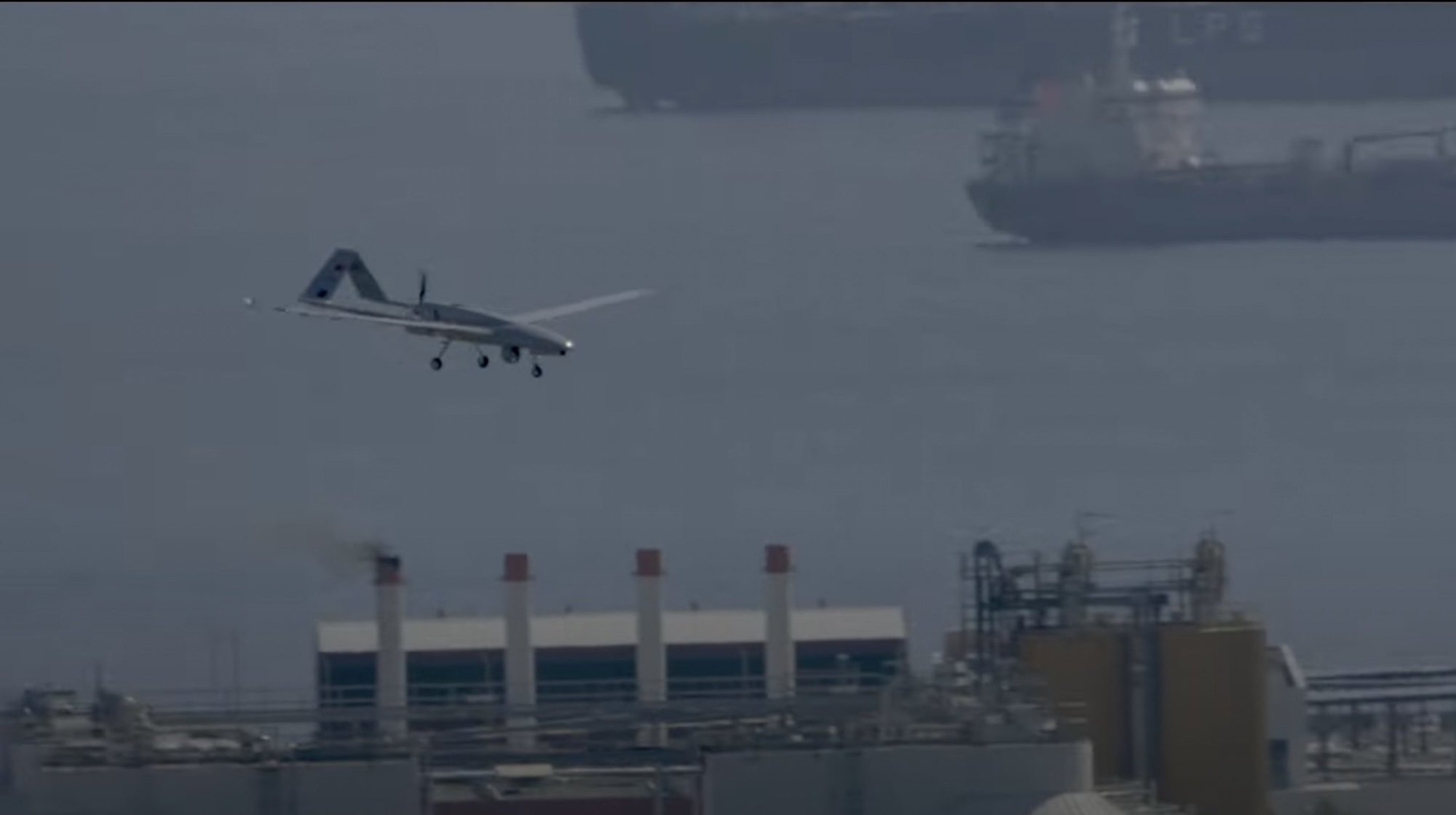
Several unsourced claims about the video describe it as filmed by a Ukrainian-owned Turkish Bayraktar TB2 drone — a likely candidate, known to be in heavy use by Ukraine for intelligence gathering and targeting — from wildly different estimates of distances. Some say just 1 mile away, another says more like 50.
Both those numbers are sheer fantasy.
One mile would be far too close for a large drone like the TB2 to approach all those anti-air systems, while 50 would be far beyond the optics of any camera on a drone to produce video clear enough to see the actual flames and details on deck, as are visible in the video.
A more realistic distance is somewhere between 6 miles (outside of most of the known range of most of those anti-aircraft systems) and 15, the farthest distance at which the optics on the TB2 are reported to be capable of spotting enemy targets, though because the ship is so large, it’s possible the cameras on a TB2 could get clear video from farther away than that 15-mile “max range.”
But that would actually make the video less likely to be real. Here’s why:
In the 37-second clip, the filming aircraft moves from roughly 45 degrees off the port side of the ship to straight off the bow. In other words, the plane appears to move about one-eighth of the way around that ship as it films.
If we assume the aircraft is orbiting the Makarov from 6 miles away — as close as it can safely approach — then it’s just a middle school math problem to figure out how fast it was flying during those 37 seconds. If the video covers roughly a 45-degree view of the ship — or one-eighth of the orbit — that means the plane flew 4.6 miles in those 37 seconds.
That’s 448 mph, several times faster than the prop-driven TB2 can fly, close to 100 mph faster than the top speed of the US Global Hawk and at the top end of performance for US spy planes like the U-2 and EC- and RC-135s that the US has flown over the Black Sea in recent months. Also worth noting is that virtually no imagery has leaked from US intelligence platforms since the war began, though the Ukrainians have been quick to release their own pictures and videos of victories.
Two USAF ISR flights today (RC-135W 62-4131 HOMER71 #AE01CC and RQ-4 FORTE11 #AE5420) over Romania can be mapped to show the reach and coverage of active combat zones by including data from @Nrg8000. We can also estimate the range to a possible target (an IL-18 based platform). pic.twitter.com/PsXkpTI4Zu
— Amelia Smith (@ameliairheart) April 10, 2022
Could anything fly that fast? The Ukrainians have fighter jets that can reach the speed of sound but they are, well, kinda busy, and almost certainly would not carry the kind of precise optics needed to capture the video.
The above speed calculations are a very rough Coffee or Die Magazine estimate and changing any of the variables — distance to the ship, angle off the bow, etc. — would change the result, but for the video to have been filmed by a drone flying its max speed of 150 mph, the drone would have to be closer than 2 miles to the “burning” ship.
And that would create one more telltale issue of fakery.
At 2 miles or less, the angle of the camera would be very different than that seen on the video. A TB2 observing a target as large as a ship is likely to fly at least 2 miles high, if not higher (its operational ceiling is close to 4 miles up), which would create a steeper “overhead” angle to the video than is seen in the clip.

So without even looking too hard at what the Admiral Makarov video shows, it’s safe to say that it’s almost surely a fake.
But what does it show?
Well, it does show a ship that bears a strong resemblance to the Makarov, and the flames and smoke look real enough.
But Twitter user Oliver Alexander quickly proved that the computer war game Arma 3 can be used to create a nearly identical scene. While writing a Twitter thread in which analyzes the supposed attack, he says he created these images in about 10 minutes:
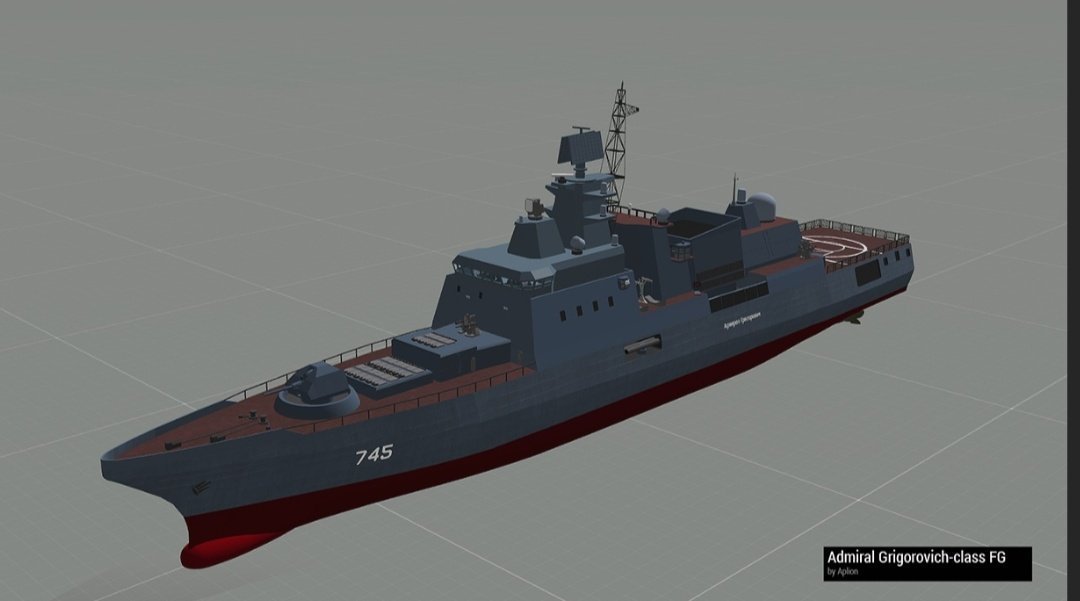
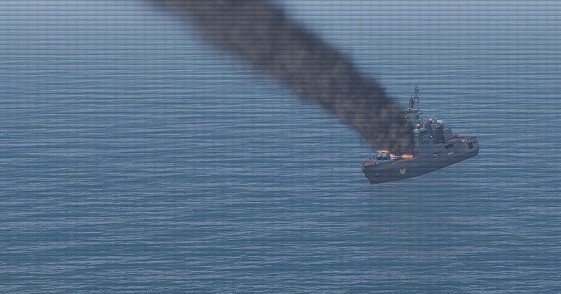
Finally, there was, from the first hours when the Admiral Makarov video emerged, a wide range of indications that nothing particularly interesting was happening in the Black Sea. Various maritime tracking sites showed no real surge of Russian ships toward the supposed attack.
Cursory analysis of Sentinel 1 radar satellite (SAR) imagery from today has not picked up any signs of a ship damaged or sunk in the area pic.twitter.com/AsrXyFVZf1
— H I Sutton (@CovertShores) May 6, 2022
Also, several online analysts who track maritime radio communications said there was no uptick in chatter on Russian frequencies.
No unusual activity on Russian Black Fleet 3531 CW kHz. Sevastopol sending routine cipher messages with at least 4 ships receiving the messages. No increase in ciphers etc. My apologies for the bad news.
— redandblackattack (@redanblacattack) May 6, 2022
Editor’s note: This article has been updated to correct the calculation of the speed an aircraft would have to fly in order to produce the “burning ship” video flying 6 miles from the ship. That speed is 448 mph. An earlier version used a calculation of that speed for an aircraft flying just over 10 miles from the ship.
Read Next:

Matt White is a former senior editor for Coffee or Die Magazine. He was a pararescueman in the Air Force and the Alaska Air National Guard for eight years and has more than a decade of experience in daily and magazine journalism.
BRCC and Bad Moon Print Press team up for an exclusive, limited-edition T-shirt design!
BRCC partners with Team Room Design for an exclusive T-shirt release!
Thirty Seconds Out has partnered with BRCC for an exclusive shirt design invoking the God of Winter.
Lucas O'Hara of Grizzly Forge has teamed up with BRCC for a badass, exclusive Shirt Club T-shirt design featuring his most popular knife and tiomahawk.
Coffee or Die sits down with one of the graphic designers behind Black Rifle Coffee's signature look and vibe.
Biden will award the Medal of Honor to a Vietnam War Army helicopter pilot who risked his life to save a reconnaissance team from almost certain death.
Ever wonder how much Jack Mandaville would f*ck sh*t up if he went back in time? The American Revolution didn't even see him coming.
A nearly 200-year-old West Point time capsule that at first appeared to yield little more than dust contains hidden treasure, the US Military Academy said.

